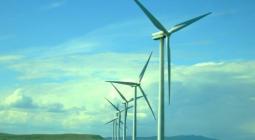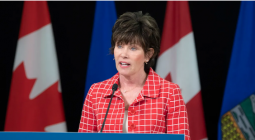Alberta to ban renewables on ‘prime’ land and preserve ‘pristine viewscapes’
Decision by premier Danielle Smith further pits Canadian province against environmental groups pushing green energy
Alberta will block renewable energy projects on “prime” agricultural land and limit the placement of wind turbines to preserve “pristine viewscapes”, a decision that increasingly pits the western Canadian province against environmental groups pushing green energy – and the companies investing in it.
The decision, announced by the premier, Danielle Smith, and utilities minister, Nathan Neudorf, on Wednesday, follows a controversial six-month ban on new renewable energy projects that is due to expire on 29 February.
Alberta’s moratorium, announced in August, left energy companies uncertain about billions in future investment, even as the region, with its clear skies and an abundance of wind, led the country in new renewable projects.
Nearly a third of Alberta’s grid is now powered by renewables and the province has shifted away from coal at a far faster rate than expected.
But Smith has pushed back against federal rules that aim to reduce the greenhouse-gas emissions of provincial power grids.
Last month, amid recording-breaking winter temperatures, Albertans were sent emergency alerts asking them to conserve power as the electrical grid buckled from the cold. Smith and others in the province used the cold snap to express skepticism about the feasibility of renewable energy.
On Wednesday, she framed the decision to put limits on new projects as one designed to grow the industry in a “well-defined and responsible” way.
“Alberta has led the country in renewable energy investment, and we will continue to lead the country,” she told reporters.
Under its new rules, Alberta will ban renewable projects on private lands that it believes have “excellent or good irrigation capability” as well as land that can grow specialty crops.
Landowners can request an exemption if they can show crops or livestock can thrive alongside the project. Developers of projects will be responsible for cleanup costs and must secure a bond with the government.
Smith said that the new rules reflect what she called “errors” in the way liability for oil and gas companies was structured in the past – and has since led to mounting crisis in the province as officials contend with roughly 170,000 “orphaned” oilwell sites.
“You don’t correct a problem by compounding it,” the premier said.
In order to preserve its vast open prairie landscapes and sight lines of the Rocky Mountains, the province will put in buffer zones at least 35 kilometres (22 miles) separating what the government believes is a “pristine viewscape” and wind turbines.
Neudorf admitted there was no “universal definition” of the term, but cited other jurisdictions, including the United Kingdom, with rules surrounding buffer zones.
Neudorf also said the policy would apply to the “vertical footprint” of all wind turbines – but that other industries that physically alter the landscape, such as coal projects or clearcut logging, would be assessed on a case-by-case basis.
The government decision was met with skepticism by renewable energy analysts, who warned the vagueness of the new rules amounted to a second “soft moratorium”.
“By introducing three new regulatory frameworks without details, investors and developers are left wondering what this actually means for their projects. Investors required certainty, and the government offered confusion,” Jorden Dye, director of the Business Renewables Centre-Canada, said in a statement.
He called the “unprecedented” 35km buffer zone a “backdoor land ban” that could eliminate the possibility of projects in three-quarters of southern Alberta.
“Overall, today’s announcement extends the climate of uncertainty and leaves us with the task of analyzing how many projects and how much investment Alberta will lose to other provinces,” he said. “Further details are needed to pin down exactly what the fallout will be. Failure to provide those details in a timely manner will also shift investment to other provinces and countries.”
Cover photo: A wind farm in the foothills of the Rocky Mountains near the town of Pincher Creek, Alberta. Photograph: Todd Korol/Reuters





